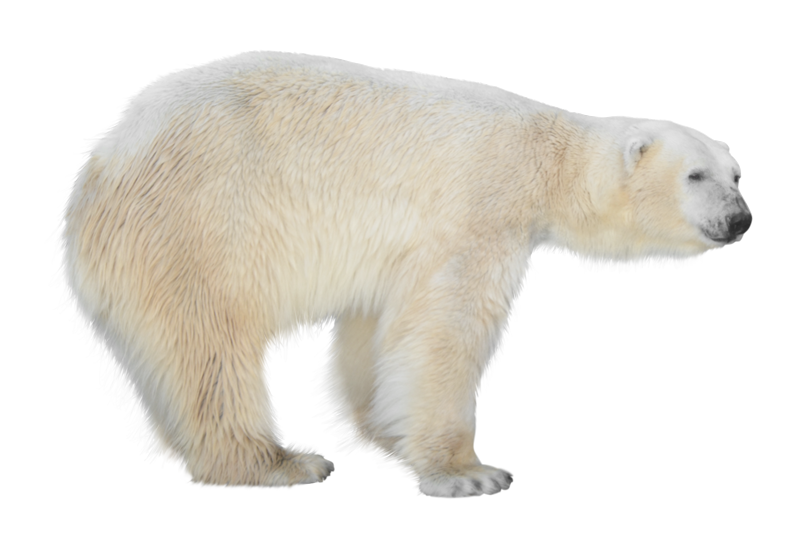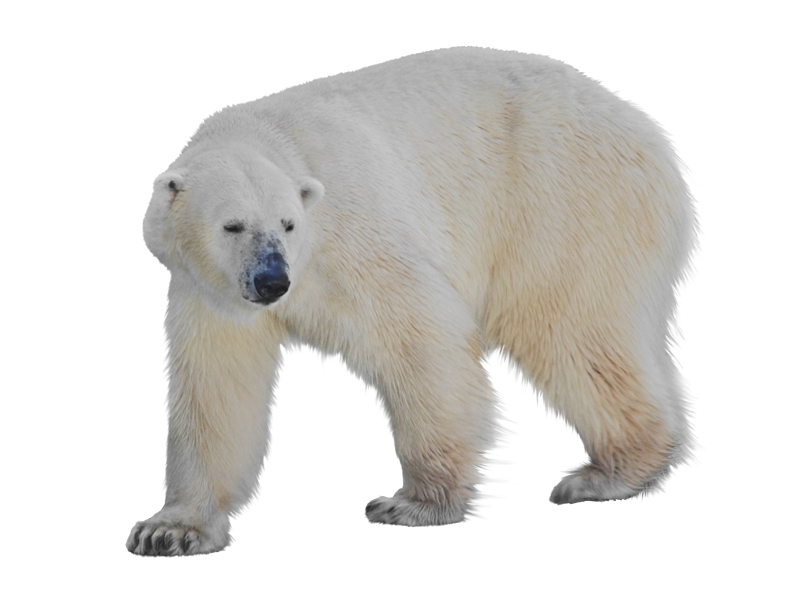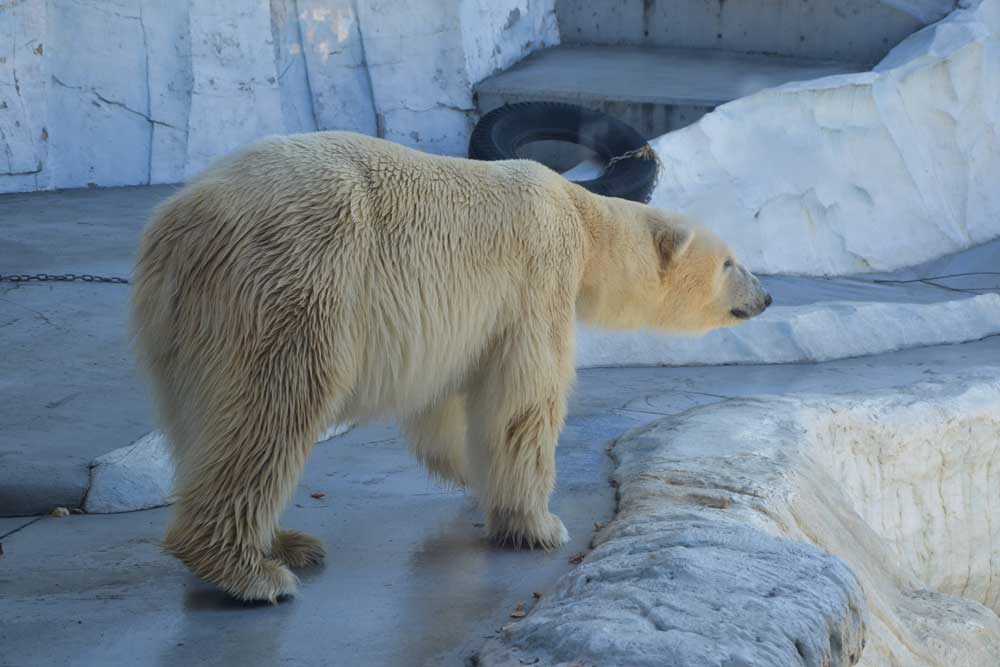
Ursus maritimus (Phipps, 1774)
北極の氷が解けはじめた時、ホッキョクグマは
As the Arctic ice begins to melt, polar bears…
北アメリカ大陸北部、ユーラシア大陸北部、北極圏に分布します。体長オス200 – 250cm、メス180 – 200cm。体重オス340 – 650kg、メス150 – 250kg。他種のクマと比較すると頭部は小さいですが、長い首を持ち、泳ぐのに適した体型になっています。足裏の肉球を除いた全身が体毛で被われていますが、体毛は白と言うよりも半透明で中が空洞になっていて、光を通し断熱効果があります。また皮膚は熱をよく吸収できるように黒色です。クマ科の中では肉食傾向が強く、捕食するほとんどがワモンアザラシです。主に狙うのは幼体ですが、自分よりも大きいセイウチも襲うこともあります。雄の平均的な体重400 kgを維持するには1日に12,000kcalを必要とし、これには1週間でアザラシ1頭の捕食を必要とします。
現在、生息域である北極圏では急激な環境の変化が起きています。気候変動の影響で海氷が溶け、北極の海氷がどんどん後退しているのです。人工衛星からの記録によると北極圏の1年以上解けずに残っている海氷は1970年から10年ごとに13%ずつ減っているそうです。海氷が減少したことでホッキョクグマはアザラシを狩るのが難しくなっています。アザラシを捕まえるために遠くまで行かなければならず、より多くのエネルギーを消費してしまいます。その結果、1984年から2009年までの25年間で、オスの平均体重が45 kg、メスの平均体重が31 kg減少しているそうです。
生息域が減少した結果ホッキョクグマは減少していくと考えられていますが、実際どうなのかは根拠となるデータが不足しています。一部の気候変動否定論者はホッキョクグマは減っていない、むしろ増えているとして、その意見に同調するブロガーも多く存在します。メディアで取り上げられる痩せ細った姿や、逆に丸々と肥えた姿など、映像や写真で報道される度に多くの関心を呼びますが、ホッキョクグマの生活の場である海氷が少なくなっていることは事実です。
さて、同じく大型のクマであるヒグマとの関係ですが、100万年以上前にヒグマとホッキョクグマの共通の祖先から枝分かれしたと考えられています。それぞれの生息地は分かれていましたが、ホッキョクグマは獲物を求めて南下したことで、ヒグマとの生息域が重なってきています。その結果、2種の交配が進みハイブリット種が生まれてきています。また獲物を巡っての争いではヒグマに分があると見られ、生存競争に敗れる可能性があります。もう一つ懸念されることは人間との衝突です。実際に北極圏のいくつかの村では、これまで見かけなかったホッキョクグマの出現に警戒しているという報道があります。
このようにホッキョクグマは環境の変化への対応に迫られており、私たちは彼らの行動を観察して、各国が協力して科学的データを集め、保全と人間との共存を考える段階にあります。

They are found in northern North America, northern Eurasia, and the Arctic. Males measure 200–250 cm in length, while females measure 180–200 cm. Males weigh 340–650 kg, while females weigh 150–250 kg. Compared to other bear species, their heads are small, but their long necks make them well-suited for swimming. Their entire body, excluding the pads on their feet, is covered in fur. Rather than white, this fur is translucent and hollow, allowing light to pass through and providing insulation. Their skin is black, allowing for better heat absorption. Among the bear family, they are particularly carnivorous, primarily targeting ringed seals. While they primarily target young seals, they will also attack larger walruses. To maintain an average male’s weight of 400 kg, they require 12,000 kcal per day, which requires consuming one seal per week.
The Arctic, their habitat, is currently undergoing rapid environmental change. Climate change is causing sea ice to melt, leading to rapid retreat in the Arctic. According to satellite data, the amount of sea ice in the Arctic that remains intact for more than a year has been decreasing by 13% every decade since 1970. The decline in sea ice is making it more difficult for polar bears to hunt seals. They have to travel farther to catch seals, which consumes more energy. As a result, over the 25-year period from 1984 to 2009, the average weight of males decreased by 45 kg and the average weight of females decreased by 31 kg.
It is believed that polar bear populations are declining as a result of habitat loss, but there is a lack of data to support this conclusion. Some climate change deniers argue that polar bear populations are not decreasing, and in fact are increasing, and many bloggers agree. Whenever polar bears are featured in the media, their emaciated or plump appearances are reported in video and photographs, attracting much attention. However, the fact remains that the sea ice in which they live is decreasing.
As for their relationship with brown bears, which are also large bears, they are thought to have branched off from a common ancestor over a million years ago. Their respective habitats were separate, but as polar bears migrated south in search of prey, their habitats have begun to overlap with those of brown bears. As a result, the two species have interbred, resulting in the creation of hybrid species. Furthermore, brown bears are believed to have the advantage in competition for prey, and there is a risk that polar bears will lose out in the struggle for survival. Another concern is conflict with humans. In fact, there have been reports that some villages in the Arctic are on alert due to the appearance of previously unseen polar bears.
Polar bears are being forced to adapt to these environmental changes, and we are now at the stage where we are observing their behavior, cooperating with other countries to collect scientific data, and considering conservation and coexistence with humans.

参考文献
ナショナルジオグラフィック | 極北のサファリ:チャーチル | (2022年1月31日) 2024年8月12日閲覧
BBC NEWS JAPAN | ホッキョクグマ、2100年までに絶滅の恐れ 気候変動で | (2020年7月21日) 2024年8月12日閲覧
スーザン・J・クロックフォード「ホッキョクグマはだいじょうぶ 心配しなくていい20の理由 (更新版)」国際環境経済研究所(2022年4月15日) 2025年8月24日閲覧
「北極の冬季海氷域面積が衛星観測史上最小を記録」大学共同利用機関法人情報・システム研究機構 国立極地研究所 (2025年4月18日) 2025年8月24日閲覧
「南下するホッキョクグマ急増、温暖化で北極圏に異変 カナダ」AFPBB News (2014年12月22日) 2025年8月24日閲覧
「どう猛なホッキョクグマが多数うろうろ…ロシアの島で非常事態宣言」AFPBB News (2019年2月10日) 2025年8月24日閲覧